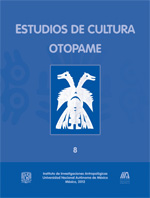"Dressing little saints". A Ritual action to dress "antiguas" among otomi people from Hidalgo
Main Article Content
Abstract
The act of dressing sacred beings, whether they belong to the Catholic or the local pantheon, constitutes one of the primordial stages of the ritual. Nevertheless, this procedure has failed to attract suitable attention among specialists when dealing with the topic of the Ofrenda. What we find in relation to the aspect, are passing mentions of the datum without any deeper analysis of the symbolic significance underlying these actions: although it might just constitute the ritual’s preparatory phase, the dressing doubtlessly is of crucial importance for the posterior efficacy of the same. Some societies consider clothing to be an inherent part of the body, as it does not only contain a person’s essence, but it is an actual part of him or her. In the indigenous conception of the body, this is a rather essential aspect because the corporal image occupies a major position in the context of the world’s order. Therefore, clothing is recognized as the most precious gift. The moment it is granted to any deity, it automatically becomes a part of the offerings, mankind is obliged to donate.

